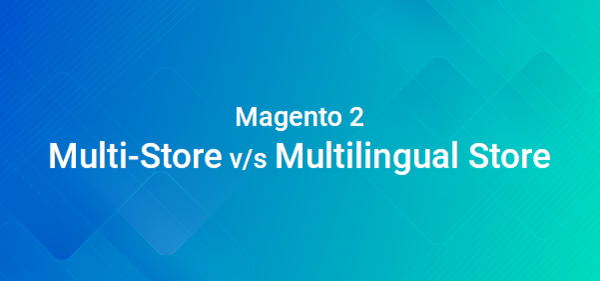While Magento offers exclusive features for businesses to run their Magento stores smoothly, there is one challenge that businesses often face – choose a multi-store or a multilingual store.
Though their features and purpose are relatable, they differ in a few ways. If you are confused about these two, you will get your answer in this article.
Here, we will explain the difference between both and the benefits of each. We will also cover the Magento 2 Language translator.
Let us get started!
Magento 2 Multi-Store
Having a Magento 2 multi-store is similar to multiple physical stores. But if you’re wondering when to build a Magento multi-store, here it is.
Imagine your eCommerce business is running well locally. The benefits and profits you’re reaping are leaping by bounds. And as time passes, you realize the need to expand your business to different regions. That’s when multi-store come into the picture.
Other reasons to set up multi-store:
Expand Globally
A customized store for every region makes a huge difference in the customers’ shopping experience. With multi-store, you can create different stores for different countries based on tastes, shopping experiences, consumer needs, and more.
For example, look at Puma’s website for different countries. Puma store for USA and Puma store for Europe.
Target Specific Customers
If you have different brands or product categories like clothes for adults and kids or B2B and B2C stores, you can have different stores. It will enhance the customer experience.
Challenges of Multi-Store
Order Processing
Managing orders on the front end looks like a piece of cake. But in reality, it’s way more complex if you have to manage thousands of orders in a day. You may end up receiving orders more than you can deliver.
Inventory Management
This is the biggest challenge that businesses having multi-store on the Magento platform face. If you have products that are available on all sites, you will have to update them on all. An auto-sync feature will be of great help, but that depends on your store’s features.
System Integration
You will have to integrate different third-party tools like ERP and POS with every store you add.
Managing Products
While adding a few products is easy, adding many products to multiple stores can be overwhelming. If you plan to categorize products based on collections and seasons, it can be cumbersome.
These are a few challenges, but you can overcome them with real-time inventory tracking, store optimization, centralized inventory management, and unified customer support.
There are many reasons to choose a multi-store, but you need to understand if it’s the right course of action for your business.
Now let’s see what a multilingual store is.
Magento 2 Multilingual Store
If you plan to expand beyond a region/state/country, personalized content with a cultural touch goes a long way. Everyone likes to feel unique and secure. And when an e-store exudes friendliness by sharing content in the native language, it’s an instant mood lifter.
For this, you will have to lift the language barriers from your Magento store and be more adaptive to different languages.
How can you do that? By integrating a Magento 2 language switcher. There’s a default option too. However, you will have to create multi-store views and set a language for each store view. Too much work!
You can also ask your Magento store developer to add the multilingual feature, but it might have limitations.
A Magento 2 language translator lets you convert each and every word on the website in your preferred language without any additional effort. A few installation steps, and it’s all set.
Why You Need Multilingual Stores
Attract Customers
Buyers feel more connected to seeing an e-store in their local language. This instant connection helps attract more customers as they better understand product details, shipping charges, and policies. It also reduces the bounce rate.
Turn Visitors into Buyers
Attracting customers is one thing and making them buy is another. If you think English is enough to make the purchase, well, roughly 13 percent of the world speaks English. If you want to reach out to others, multilingualism is the only way. For that, you need a feature-rich Magento 2 Language Translator.
A 2020 CSA research found that 76 percent of online shoppers prefer to buy in their native language while 40 percent will never buy in any other language.
Top SEO Chart
Using a multilingual store might achieve better visibility, a strong brand identity, and more revenue. In addition, you can target the extra queries which you couldn’t target in English. For example, FAQs or product descriptions.
A multilingual store is the first step to enhance customer experience, which further grows into business expansion, customer retention, and sales.
However, multilingualism has its challenges, such as content management, wrong translations, app compatibility, expenses, etc. To overcome them, you should bring in a language translator.
How does our Magento 2 Language Switcher Help?
- It lets you translate the website’s content into the language of your choice. You can then edit the final output using the WYSIWYG editor.
- It offers an all-inclusive translation, which means you can translate any piece of the website content, including categories, review pages, and metadata.
- There’s a facility for mass translation. You can set daily translation limits and even translate content for multiple stores simultaneously. Last but not least, you can import/export external files easily.
Conclusion
If your purpose is to improve customer experience, go for a multilingual store. However, if you want to expand and create a separate identity for each brand, a multi-store will be a better option.
You can also create a multi-store with a multi-language feature.
Precisely, choosing what you want depends on your business requirements and key goals. Ready to take the plunge?
All product and company names are trademarks™, registered® or copyright© trademarks of their respective holders. Use of them does not imply any affiliation with or endorsement by them.





